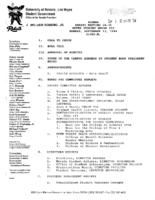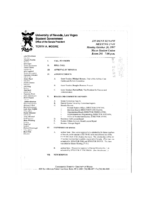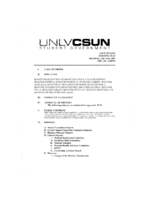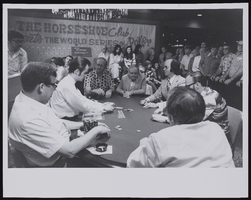Search the Special Collections and Archives Portal
Search Results
Ron Lurie Papers
Identifier
Abstract
The Ron Lurie Papers are primarily comprised of photographs, newspaper clippings, and daily planners from 1972 to 1990 that document Ron Lurie's political career as a city councilman and a mayor of Las Vegas, Nevada. The collection also includes a small amount of correspondence and ephemera, mainly letters that were mailed to Lurie along with photographs. The photographs in the collection depict events and activities that Lurie participated in, and the newspaper clippings document city and state politics in addition to Lurie's political career.
Archival Collection

Yeon-Kyung (Mar) Chung oral history interview: transcript
Date
Archival Collection
Description
Oral history interview with Yeon-Kyung (Mar) Chung conducted by Emilee Caivin on November 10, 2021 for Reflections: The Las Vegas Asian American and Pacific Islander Oral History Project. In this interview, Yeon-Kyung (Mar) Chung talks about her upbringing in Korea and her educational history, studying Spanish abroad in Spain and Italy before earning her graduate degree in Latin American Studies from the University of Texas, Austin. Mar Chung talks about her move to Las Vegas, Nevada in 1999 to enroll at the College of Southern Nevada and the University of Nevada, Las Vegas to pursue pharmaceutical studies like her parents. She talks about her experience as a single mother, her path to citizenship in the United States, and the Las Vegas Asian American community. Mar Chung also reflects on differences between how she was raised compared to the upbringing of her two children.
Text
Hattie Canty oral history interview
Identifier
Abstract
Oral history interview with Hattie Canty conducted by Claytee White on February 27 and June 17, 1998 for the Las Vegas Women Oral History Project. In this interview, Hattie Canty recalls moving to Las Vegas, Nevada in the late 1960s and working as a maid for the Thunderbird Hotel and Casino and later the Maxim Hotel and Casino. Canty discusses her tenure as the Culinary Union Local 226 President during which she faced several labor challenges and went to jail at least six times while striking. Hattie also recalls how she influenced contract negotiations for the downtown hotels, improved race relations among workers, involved more members in union operations, and implemented the Culinary Training School.
Archival Collection

Transcript of interview with Cynthia Cicero, Tina Boag, Betty Brown, and Jan Ravetti by Claytee D. White, March 28, 2014
Date
Archival Collection
Description
Text

Transcript of interview with Sharon and Henry Hwang by Stefani Evans and Claytee D. White, February 21, 2017
Date
Archival Collection
Description
Text

Meeting minutes for Consolidated Student Senate University of Nevada, Las Vegas, September 12, 1994
Date
Archival Collection
Description
Text

Meeting minutes for Consolidated Student Senate University of Nevada, Las Vegas, October 20, 1997
Date
Archival Collection
Description
Text

Meeting minutes for Consolidated Student Senate, University of Nevada, Las Vegas, July 25, 2005
Date
Archival Collection
Description
Text

Meeting minutes for Consolidated Student Senate, University of Nevada, Las Vegas, August 7, 1979
Date
Archival Collection
Description
Text

Photograph of Benny Binion and others playing poker, Las Vegas (Nev.), circa 1980
Date
Archival Collection
Description
Benny Binion seated at poker table with his hands folded and facing camera. The photograph being taken during Horseshoe World Series of Poker circa 1980.
Image
